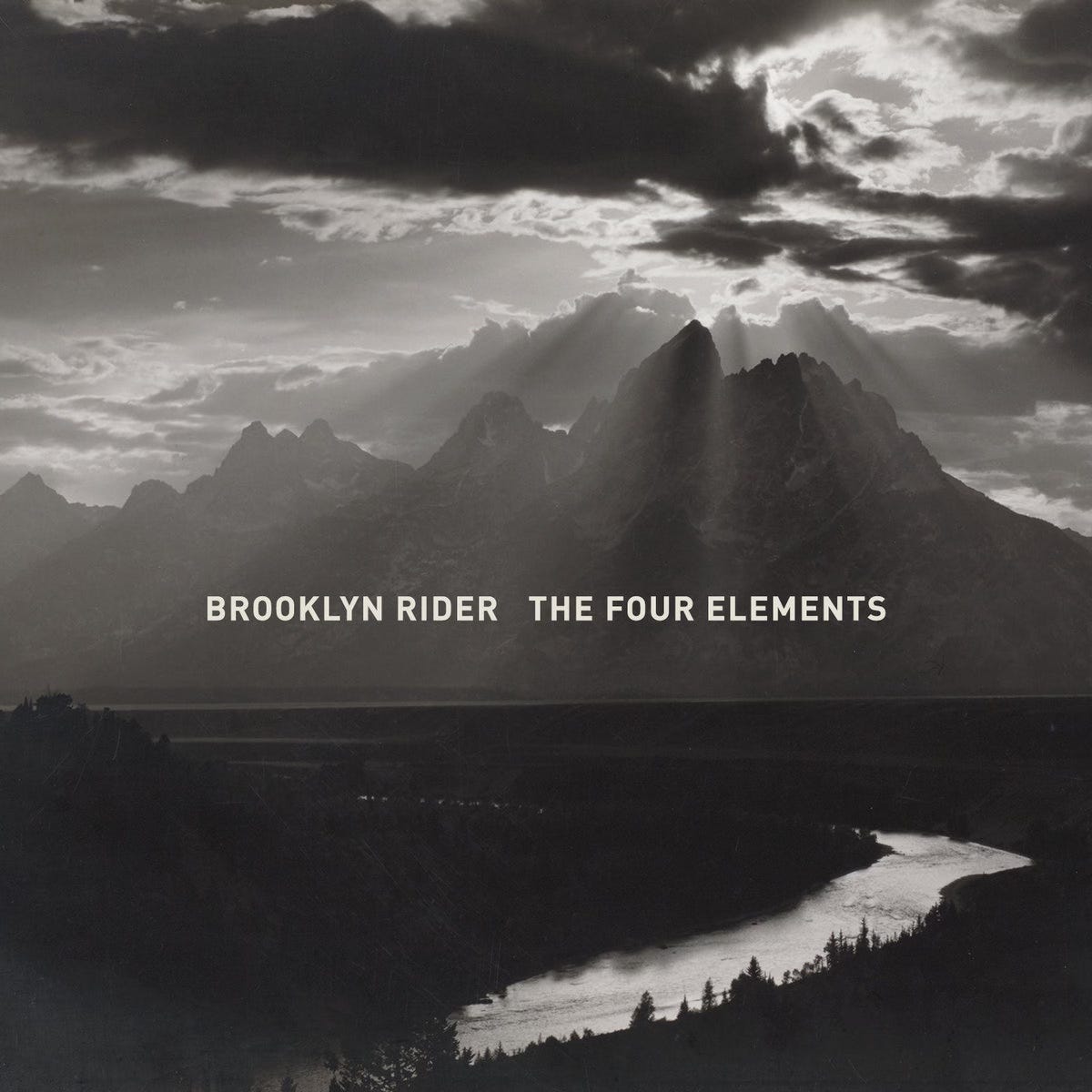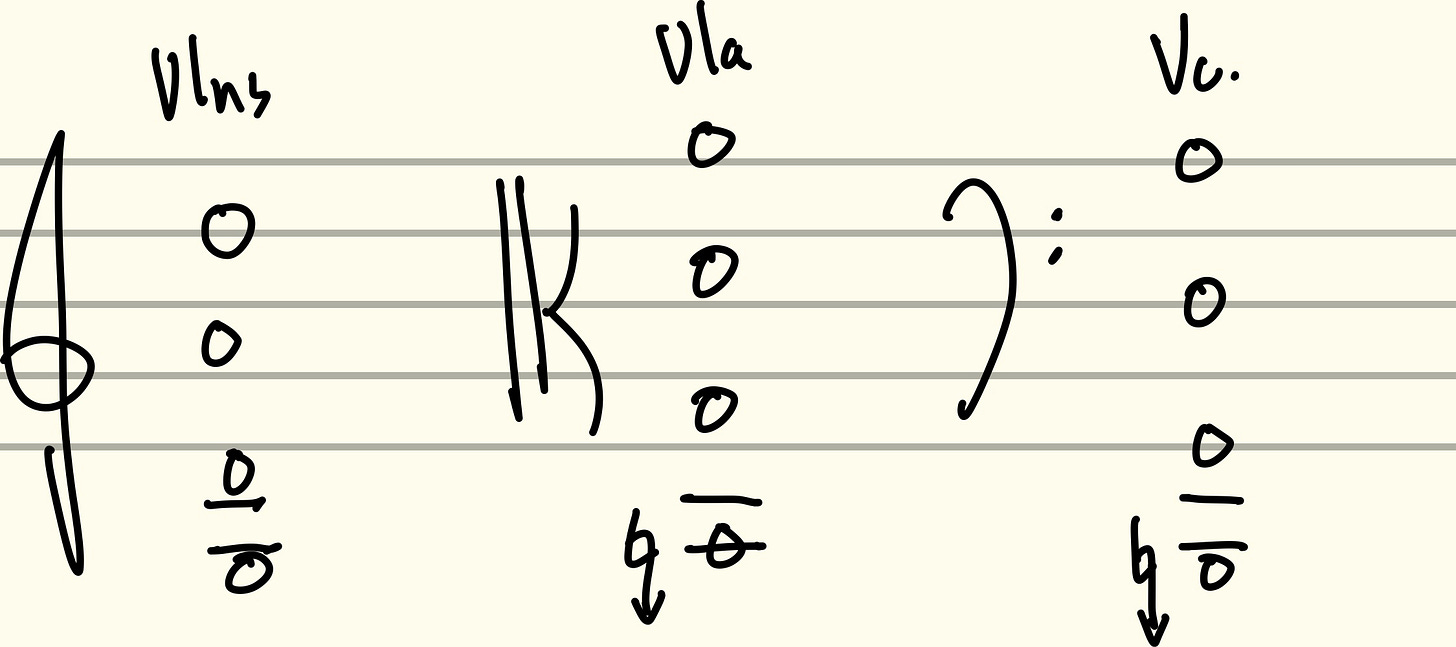I am so pleased to share the release of the new Brooklyn Rider album, The Four Elements, which features a two-part piece of mine called Under My Feet / Up There. Feel free to listen here, and I highly recommend the whole record, which features a wonderful mix of interesting music.
Brooklyn Rider will be performing these live at Lincoln Center in August!
When Colin Jacobsen of Brooklyn Rider reached out to me about this project, I was delighted, in particular because the group wanted me to take on the element “earth” (each composer was asked to consider one of the four elements in approaching our pieces). I wrote these notes for Part I: Under My Feet:
Under my feet, I might find, among other things:
The ground
Where billions of cicadas live, somewhere during their 17-year life cycle
What I stomp when playing fiddle for dancing
Roots
The medium for Earthbenders in Avatar
Or what Orogenes move (or where Stone Eaters live) in NK Jemisen's "The Broken Earth" series
Memories of a song ("I Feel The Earth Move...")
Where most life begins, and ends
Where "The Really Big One" will happen, sooner or later
My sense of place
Tectonic plates, perhaps in a state of slow subduction
A scale, to measure my weight
Where lightning strikes
And so on. The earth under our feet is rich, constantly changing, the source of and resting place for life itself. It is in motion, sometimes very quickly, but mostly so slowly that we build our life coordinates around it: the location of trees, houses, streets, rivers, seem constant—and we need them to seem that way—but they are not. In the words of Kathryn Schulz, from her article The Really Big One: “The brevity of our lives breeds a kind of temporal parochialism—an ignorance of or an indifference to those planetary gears which turn more slowly than our own.”
In Under My Feet, different strata of movement coexist, sometimes synchronized, other times at odds, at convergent, divergent, or transform boundaries, like tectonic plates and all they carry, or dancers on the floor.
And, foot-stomping abounds in this piece.
After its first performances, I felt it wasn’t done, and began composing Part II: Up There, in a hotel room in Amsterdam shortly after a performance there. My notes for that one:
The flow of electrical fluids in Earth’s outer core creates a magnetic field surrounding the planet, essentially casting its insides to the outside and protecting life from solar and cosmic radiation. This magnetic field itself vibrates resonantly, at overtones of a very low frequency known as the Schumann Resonance, named after the scientist that predicted them in the 1950s (not the composer!). The fundamental, 7.83Hz, is approximately a very low B, and the low strings of the viola and cello are tuned to B a few octaves above that for these pieces. Also, the 16th-note in Up There goes by at approximately 7.83Hz, or 470bpm, so the quarter-note, the basic pulse here, is essentially an undertone to this frequency.
Up There then is intended to be in resonance with the Earth’s magnetic field in multiple ways, at least theoretically. Schumann the composer, while not the namesake of these resonances, does make a cameo in this work, via a reimagining of a stunning passage from his song “Auf Einer Burg,” which begins with the line “Up there in his look out.”
In any case, the interactions of Earth’s vibrating, protective magnetic field with the solar wind create the stunning aurora borealis. My mother used to see these in her childhood, growing up in northern Minnesota, and I used to as well, when visiting as a child and when I was in college there; it is a kind of naturally emergent artwork that is shared by creatures living near either pole—what a gift! Coincidentally—or not— Up There was composed during a particularly strong solar storm, and the aurora borealis showed its colors as far south as North Carolina and Arizona!
And if Part I: Under My Feet of this work is about humans and their awareness of what is beneath them, perhaps Part II: Up There is about Earth looking up from underneath, wrapping their magnetic arms around us, enveloping us in a protective dance.
I’m so glad that Brooklyn Rider was game to take on both parts of this piece, in part because it really just doesn’t feel complete in either half; they are in balance, in a way, and the first seems to slowly descend, the second to slowly rise.
The quartet is in scordatura for these pieces, with the top string of the violins tuned down a whole-step, and the bottom string of the viola and cello tuned down a half-step:
This leaves the low B-strings in a nice just-tuned (6/5) relationship with the top D-strings, and creates some opportunities to explore different resonances in the ensemble, and of course different double-stop finger patterns and natural harmonics on the open strings.
More on this in upcoming posts, but this piece has turned out to be the first of many exploring scordatura in quartet writing; I’ve composed several more, including some quintets where I join the quartet, all in collaboration with the wonderful Bergamot Quartet—I’ll write about these in the coming year leading to our first record together. And, even more, this has been key the Hardanger Quartet project that I have been working on, again in collaboration with Bergamot; soooo exciting, and more on all that soon!
If you’d like a look at the score, here you go:






